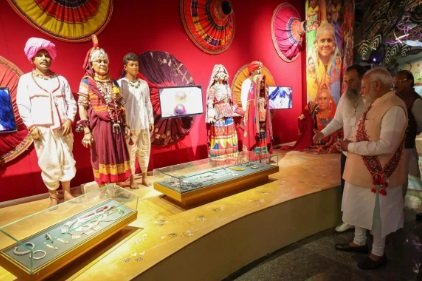The Banjara Virasat ‘Nagara’ Museum, recently inaugurated by Prime Minister Narendra Modi in Pohradevi, Washim district, Maharashtra, is a cultural landmark dedicated to the Banjara community’s vibrant history and traditions. Pohradevi, often referred to as the “Kashi of the Banjara Community,” is a spiritually significant site, making it a fitting home for this museum, which celebrates the community’s unique legacy.
Museum Structure and Exhibits
Housed in a modern four-story building, the Banjara Virasat ‘Nagara’ Museum features 13 galleries, each highlighting various aspects of the Banjara people’s rich heritage. Through carefully curated exhibits, visitors can explore the lives of key Banjara leaders, historical movements, and the artistic and cultural contributions of this nomadic community. From traditional Banjara crafts and textiles to depictions of their vibrant festivals and daily life, the museum offers a comprehensive view of the community’s unique customs and traditions.
The museum’s structure and layout are designed to provide an engaging experience. Interactive displays and immersive exhibits draw visitors into the world of the Banjaras, giving them a deeper understanding of the community’s way of life. The careful preservation and presentation of artifacts make it an educational resource for those interested in learning about this lesser-known yet culturally rich community.
Historical and Spiritual Significance of Pohradevi
Pohradevi is a place of immense historical and spiritual importance for the Banjara people. It is home to the tomb of Sant Sewalal Maharaj, a highly revered spiritual leader of the Banjara community, and the shrine of Ramraobapu Maharaj. These sacred sites make Pohradevi not only a historical landmark but also a place of pilgrimage, drawing Banjaras and other devotees from across the country. The decision to locate the museum here adds to its spiritual depth, as visitors can explore the cultural exhibits while paying homage to these spiritual leaders.
Modern Facilities and Visitor Experience
The five-story museum offers state-of-the-art facilities designed to enhance the visitor experience. With organized galleries and exhibits, the museum ensures that guests can fully immerse themselves in the rich cultural tapestry of the Banjara people. The blend of modern infrastructure with historical content allows for an engaging and informative journey through time, making it accessible to a wide range of visitors.
Development and Tourism Initiatives
The Banjara Virasat ‘Nagara’ Museum is part of a broader initiative aimed at preserving and promoting Banjara heritage. Spearheaded by Guardian Minister Sanjay Rathod, this project seeks to not only protect the cultural identity of the Banjaras but also boost tourism in the region. By attracting visitors to this historically significant site, the initiative is helping to bring attention to the unique contributions of the Banjara community while promoting economic growth through cultural tourism.
Inauguration Highlights
The museum’s inauguration was a grand affair, attended by several dignitaries, including the Governor and Chief Minister of Maharashtra. During the event, Prime Minister Modi paid his respects at the tombs of Sant Sewalal Maharaj and Ramraobapu Maharaj and also visited the nearby Jagdamba Temple, further underscoring the spiritual significance of Pohradevi. The opening of the museum marks a significant step in preserving Banjara heritage and ensuring that future generations can learn about this important community.
A Cultural Beacon for Future Generations
The Banjara Virasat ‘Nagara’ Museum stands as a vital cultural hub, offering insights into the Banjara community’s history, art, and traditions. It is not only a center for education and preservation but also a tourist attraction that brings attention to the deep-rooted heritage of the Banjaras. By celebrating their contributions and preserving their legacy, the museum plays a crucial role in keeping the community’s culture alive for future generations to appreciate and learn from.
This museum, with its rich exhibits and historical significance, serves as a reminder of the importance of cultural preservation in a rapidly changing world, offering a space for reflection, education, and celebration of the Banjara way of life.


